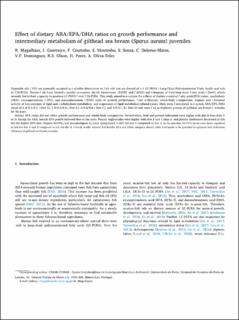| dc.contributor.author | Magalhães, Rui Pedro Moreira de | |
| dc.contributor.author | Guerreiro, Ines | |
| dc.contributor.author | Coutinho, Felipe | |
| dc.contributor.author | Moutinha, Sara | |
| dc.contributor.author | Sousa, S. | |
| dc.contributor.author | Delerue-Matos, Christina | |
| dc.contributor.author | Domingues, Valentina F. | |
| dc.contributor.author | Olsen, Rolf Erik | |
| dc.contributor.author | Peres, Helena | |
| dc.contributor.author | Oliva-Teles, Aires | |
| dc.date.accessioned | 2020-03-31T09:09:53Z | |
| dc.date.available | 2020-03-31T09:09:53Z | |
| dc.date.created | 2020-01-14T17:39:37Z | |
| dc.date.issued | 2019 | |
| dc.identifier.citation | Aquaculture. 2020, 519 | en_US |
| dc.identifier.issn | 0044-8486 | |
| dc.identifier.uri | https://hdl.handle.net/11250/2649605 | |
| dc.description.abstract | Vegetable oils (VO) are generally accepted as valuable alternatives to fish oils but are devoid of n-3 LC-PUFA (Long-Chain-Polyunsaturated Fatty Acids) and rich in C18-PUFA. Marine fish have limited capacity to express Δ6/Δ5 desaturases (FADS1 and FADS2) and elongases of very-long-chain fatty acids (Elovl), which severely limits their capacity to produce LC-PUFA from C18-PUFA. This study aimed to evaluate the effects of dietary essential fatty acids(EFA) ratios, arachidonic (ARA), eicosapentaenoic (EPA), and docosahexaenoic (DHA) acids on growth performance, feed utilization, whole-body composition, hepatic and intestinal activity of key-enzymes of lipid and carbohydrate metabolism, and expression of lipid metabolism-related genes. Diets were formulated to include ARA/EPA/DHA ratios of 2.0/0.2/0.1 (Diet A); 1.0/0.4/0.4 (Diet B); 0/0.6/0.6 (Diet C); and 0/0.3/1.5 (Diet D) and were fed to triplicate groups of gilthead sea bream juveniles for 56 days.
Dietary EFA ratios did not affect growth performance and whole-body composition. Nevertheless, feed and protein utilization were higher with diet B than diets C or D. Except for ARA, muscle EFA profile followed that of the diets. Plasma triglycerides were higher with diet B and C than A, and plasma cholesterol decreased in fish fed the higher DHA diet. Hepatic ELOVL5 and phospholipase A2 were upregulated in fish fed diet C compared to diet A. In the intestine, ELOVL5 levels were down-regulated in fish fed diet A and D compared to fish fed diet B.
Overall, results showed that besides EPA and DHA, adequate dietary ARA level needs to be provided to optimize feed utilization efficiency of gilthead sea bream juveniles. | en_US |
| dc.language.iso | eng | en_US |
| dc.publisher | Elsevier | en_US |
| dc.rights | Attribution-NonCommercial-NoDerivatives 4.0 Internasjonal | * |
| dc.rights.uri | http://creativecommons.org/licenses/by-nc-nd/4.0/deed.no | * |
| dc.title | Effect of dietary ARA/EPA/DHA ratios on growth performance and intermediary metabolism of gilthead sea bream (Sparus aurata) juveniles | en_US |
| dc.type | Peer reviewed | en_US |
| dc.type | Journal article | en_US |
| dc.description.version | acceptedVersion | en_US |
| dc.source.volume | 516 | en_US |
| dc.source.journal | Aquaculture | en_US |
| dc.identifier.doi | https://doi.org/10.1016/j.aquaculture.2019.734644 | |
| dc.identifier.cristin | 1772947 | |
| dc.description.localcode | © 2020. This is the authors’ accepted and refereed manuscript to the article. Locked until 31 October 2021 due to copyright restrictions. This manuscript version is made available under the CC-BY-NC-ND 4.0 license http://creativecommons.org/licenses/by-nc-nd/4.0/ | en_US |
| cristin.unitcode | 194,66,10,0 | |
| cristin.unitname | Institutt for biologi | |
| cristin.ispublished | false | |
| cristin.fulltext | postprint | |
| cristin.qualitycode | 1 | |

